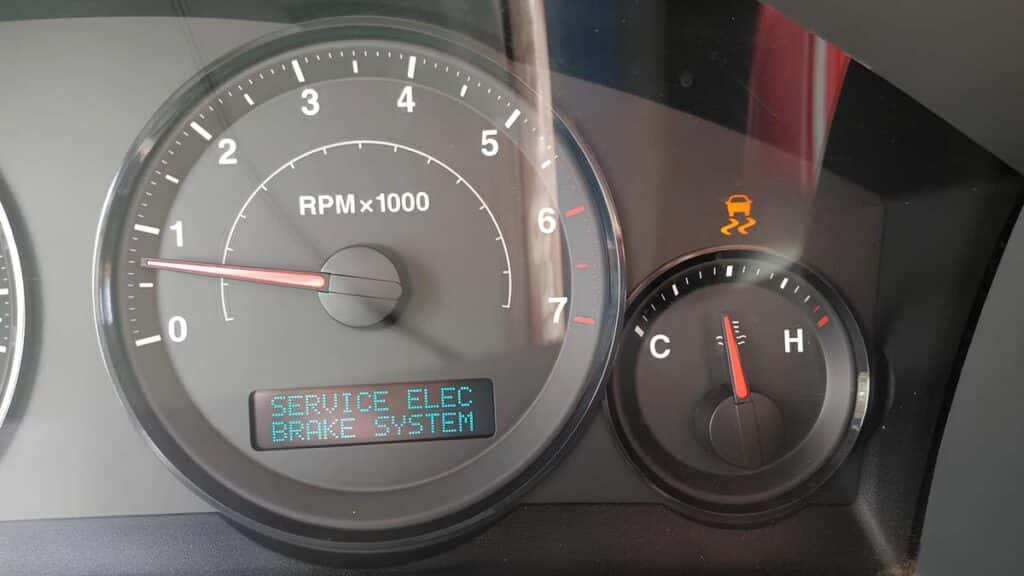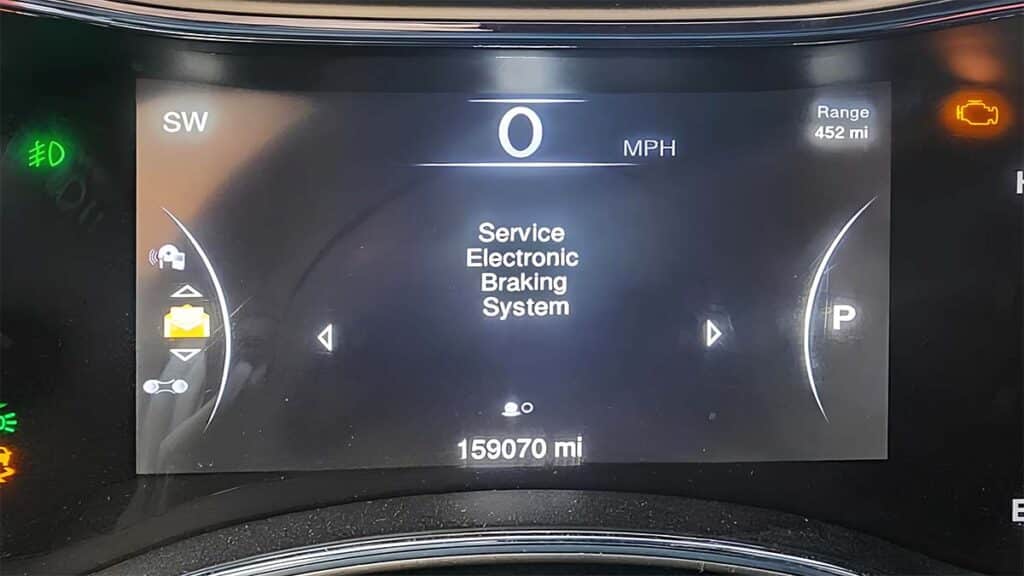10 Tips To Fix Service Electronic Braking System Jeep Warning
As a proud owner of a Jeep, you probably value its dependability. But there’s one persistent issue that has caught the attention of many – the “Service Electronic Braking System” warning on the dashboard.
If your Jeep experiences a failing battery or low brake fluid, damaged sensors, worn-out brake pads, wheel bearing issues, or damaged wiring, it can trigger the “Service Electronic Braking System” warning. Problems with the ABS module, a faulty ABS control unit, and a failing Electronic Brake Control Module (EBCM) also contribute to the warning.

In this article, you’ll find essential advice on what to do when faced with the “Service Electronic Braking System” message, uncover common causes, and discover practical solutions to address issues affecting your electronic brakes.
Table of Contents
What Is the Principle of the Electronic Braking System (EBS)?
Your Jeep’s Electronic Braking System (EBS) combines mechanical and electronic parts to function in unison with the Traction Control System (TCS) and Anti-lock Braking System (ABS).
Unlike traditional hydraulic braking systems, the EBS employs advanced electronic elements to elevate braking performance, stability, and control.
At the heart of the EBS is the Electronic Brake Control Module (EBCM), acting as its brain.
This sophisticated electronic control unit monitors vehicle parameters like wheel speeds, brake pedal input, and stability.
Using this data, the EBCM calculates the precise braking force needed for each wheel in real-time.
To maintain stability and avoid wheel lock-up when braking, it then gives the Hydraulic Control Unit (HCU) instructions on how much brake pressure to apply or release.
Wheel Speed Sensors at each wheel hub track rotational speed and produce electrical signals. This information allows the EBCM to detect wheel lock-up or loss of traction.
In an emergency, ABS keeps wheels from locking up, and TCS increases traction and stability by varying engine power or applying brakes to particular wheels when it senses wheel slip.
This integrated approach optimizes your Jeep’s braking and acceleration experience.
What Does the Service Electronic Braking System Warning Mean?
The “Service Electronic Brake System” warning in your Jeep indicates a problem with the Electronic Brake System (EBS), particularly associated with sensors.
The EBS is a sophisticated electronic braking system that manages brake functions based on electronic signals rather than traditional mechanical components.
The Electronic Brakeforce Distribution (EBD), which calculates and applies different brake force to individual wheels, functions in tandem with the EBS.
This variation is essential because not all tires require the same brake force for optimal braking.
Special sensors, including speed sensors, Yaw sensor, and steering wheel angle sensor, enable the EBS and EBD to measure factors like wheel slip ratio and brake force.
When these sensors encounter problems, the EBS struggles to manage brakes effectively, triggering the warning message.
The EBS utilizes the Anti-Lock Braking System (ABS) to adjust brake force accurately at each wheel.
The “Service Electronic Brake System” warning on your dashboard is a serious alert about a braking system issue.
The ABS, parking brake light, and BRAKE lights can also indicate potential problems.
Continuous illumination of these lights or irregular triggering suggests a need for immediate attention to prevent accidents.

What Causes the Service Electronic Braking System Warning in a Jeep? How Do You Fix It?
When the “Service Electronic Braking System” error message appears in your Jeep, it’s likely accompanied by other warning lights such as ABS and Traction Control, along with the inactivity of features like cruise control.
Before diving into potential causes, check if any safety features were accidentally deactivated, like the traction control button.
Diagnosing the exact cause is crucial, and you can achieve this through a physical inspection of Electronic Brake System (EBS) components or by using an OBDII scanner, the latter being a quicker option.
In the following sections, we’ll explore the common causes triggering the “Service Electronic Brake System” warning and effective ways to address and fix this issue in your Jeep.
Faulty Battery
A faulty battery can cause various problems. If your battery fails, it directly affects the Electronic Brake System (EBS) in your Jeep because the EBS relies on a continuous flow of current.
Given that the EBS is an electrical component, its functionality depends on a sufficient electricity supply primarily provided by the car’s battery.
When the battery is in poor condition, the EBS system can malfunction, triggering the appearance of the “Service Electronic Brake System” message.
To address this issue, inspect the battery, wires, and terminals. Ensure the battery terminal is clean.
If the problem persists despite cleaning, it may indicate a severely damaged battery.
Unfortunately, a completely damaged battery cannot be repaired, so it’s crucial to replace it promptly.
Low Brake Fluid
If your brake fluid levels are low, it will trigger the warning light in your brake system.
To address this issue, you need to monitor and replenish the brake fluid consistently.
Make it a routine to check for any potential fluid leaks each morning before starting your car.
By maintaining an adequate brake fluid level and promptly addressing any leaks, you can ensure the optimal functioning of your brake system and prevent the “Service Electronic Brake System” warning light from activating.
Failing Sensors
The sensors are crucial in the Electronic Braking System (EBS), providing essential data for brake actions.
Your EBS relies on various sensors, including speed sensors, brake force sensor modulators, yaw sensors, and steering wheel angle sensors.
If any of these sensors are damaged, it can lead to miscalculations in brake execution, triggering the “service electronic brake system” warning light.
The wheel speed sensor is a common issue that affects traction control and ABS functionality.
Your Jeep may display an electronic braking system error when this sensor fails.
The wheel speed sensor communicates with control modules, detecting wheel blockage or slipping.
If it malfunctions, the vehicle may think the wheels are permanently blocked or slipping, prompting the warning light.
To address this, replace and recalibrate the malfunctioning sensor. Use a scan tool to identify the specific sensor causing issues, run tests, and consult your owner’s manual to locate and inspect the sensor.
If the sensor or its wire shows damage, consider immediate replacement for optimal brake system functionality.
Deteriorating Wheel Bearing
When wheel bearings deteriorate, they often generate vibrations and produce a whining noise, especially at higher speeds.
This vibration affects your driving comfort and poses a risk to nearby components like wheel speed sensors and other braking system sensors located on or near the wheel hub.
Over time, these sensors may malfunction, triggering potential braking system error messages.
Checking wheel bearings can be challenging without a car lift. If your dashboard displays the “service electronic brake system” error, I advise you not to hit the highway and drive at high speeds just to assess for whining noises.
Doing so can compromise safety. If you suspect issues with wheel bearings contributing to braking system errors, I recommend having a professional inspection to ensure optimal safety and performance.
Worn-Out Brake Pad
Your brake pad plays a crucial role in the Electronic Braking System (EBS) and the overall brake system. When the brake pad wears out completely, it makes braking much more challenging.
You may notice a slower braking response, requiring repeated hits on the brake pedal before it engages.
As the EBS activates worn-out brake pads, they demand more brake force, but you’ll observe less impact on how the affected wheels slow down.
This diminished responsiveness triggers the “service electronic brake system” warning message, indicating a less effective braking system.
Let’s face it; sometimes, we forget to maintain our brake pads until the brake disk starts squealing, signaling the need for maintenance. Worn-out brake pads are risky, leading to poor stopping power and triggering the brake warning light.
Identifying a worn-out brake pad is possible by paying attention to sounds when braking.
If you hear a screeching noise from one or more wheels, it may indicate a worn-out brake pad.
Inspect the brake pad, and if the friction material is depleted or in its last year, it’s crucial to replace the brake pad promptly for optimal braking performance and safety.
Wiring Issues
In some instances, the appearance of the “Service Electronic Braking System” error message is linked to damage to the electronic brake wiring.
These wires are susceptible to damage as they lack proper coverage, and a sudden impact, like a rock from your Jeep’s wheel, can easily harm them.
Addressing wiring issues requires professional assistance, as diagnosing and resolving such problems without the necessary skills and tools is nearly impossible for the average person.
Given that the Electronic Braking System (EBS) relies on a wire connection to receive current flow, any issues with the wiring can impede its proper functioning.
Corroded, exposed, or broken wires can disrupt the current flow, slowing down or cutting off the EBS operation.
To tackle wiring problems, consult your owner’s manual for a complete vehicle wiring diagram.
Locate the wire associated with the EBS system and inspect it for corrosion, disconnection, or other damages.
If any issues are identified, a professional must replace the damaged wire to ensure the EBS functions optimally.
Fluid Leakage in the Braking System
If you observe a hydraulic fluid leakage from your brake system, the “Service Electronic Braking System” warning light will illuminate, signaling a serious issue.
There is a serious chance of catastrophic brake failure in this scenario. It is crucial not to attempt to drive the vehicle for your safety.
Instead, promptly call for a towing service to address the fluid leakage issue and ensure the proper functioning of your braking system.
Defective ABS Module
If your Jeep’s ABS control module is experiencing issues, it’s a relatively uncommon occurrence.
However, if the module has been exposed to water or sustained damage, it’s likely the problem lies within the ABS module. Unfortunately, repairing this module isn’t feasible; replacement is necessary if it malfunctions.
Driving with a faulty ABS module is not recommended.
If you must move the vehicle, proceed cautiously to a repair shop or dealership.
Ensure the brakes engage correctly and don’t feel loose when pressing the pedal.
Malfunctioning ABS Control Unit
If the control unit of your electronic braking system is malfunctioning, the brake system warning light can illuminate.
In such a situation, taking your car to a mechanic for a thorough diagnosis and, if necessary, replacing the faulty ABS control unit is advisable.
To solve the problem and guarantee that your braking system is operating properly, get expert help.
Faulty Electronic Brake Control Module (EBCM)
If the Electronic Brake Control Module (EBCM) is experiencing issues, it can significantly impact the normal functioning of your brake system.
The EBCM is responsible for communication with the Engine Control Unit (ECU) and oversees every aspect of the brake system.
In the event of EBCM damage, the brake safety system may come to a complete halt, affecting the overall performance of the brake system.
Addressing a malfunctioning EBCM can involve a reset if the issue is a simple malfunction.
You can perform a reset by disconnecting the battery for a while. However, if the module is damaged beyond repair, replacement is necessary.
I recommend having a professional handle the replacement, especially if reprogramming is required for optimal functionality.
Seek expert assistance to guarantee accurate diagnosis and successful fixing of the problems with the Electronic Brake Control Module.

Can I Keep Driving With This Message on the Dash?
Driving with the “service electronic braking system” message on the dash is not advisable, even if the brakes feel normal.
Accidents could occur if you suddenly lose your ability to brake. First, check if the brake pedal responds appropriately. If not, stop safely and call a tow truck. If the pedal is okay, drive cautiously to a service center.
While it may be safe for a short distance, don’t push your luck.
Some cars show the brake pad warning light with 10-15% material remaining.
It’s wise to seek immediate brake pad replacement. While skilled individuals can replace brake pads, prioritize quality to avoid accidents.
Ignoring brake system repairs can lead to severe accidents, risking lives and property.
Always use the correct brake pads, check hydraulic fluid levels, and don’t delay brake system repairs.
Some warning lights may not need immediate attention but consult a mechanic immediately.
When the message appears, find a safe spot to stop, drive slowly, use emergency blinkers, turn off the engine, and explore the tips in this article.
While diagnosing without tools is limited, take basic steps before contacting the dealer.
Also Read: How Do You Fix the Service 4WD Light on Your Jeep? (Solved)
Final Words
Taking care of your vehicle’s braking system, especially when it displays a message like “Service Electronic Braking System” in your Jeep, requires caution.
Diagnosing the issue isn’t easy and may involve various brake components.
While the article provides steps to address the issue independently, professional help remains invaluable.
Brake systems, particularly in newer car models, can be complex, demanding expert attention for proper diagnosis and resolution.
When the electronic braking system warning light appears, understanding the type of warning is crucial before taking any action.
Adhering to manufacturer recommendations, monitoring warning lights, and promptly addressing any issues contribute to the effective care of your Jeep’s Electronic Braking System, enhancing safety on every journey.
